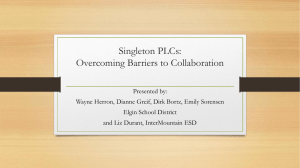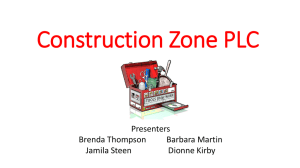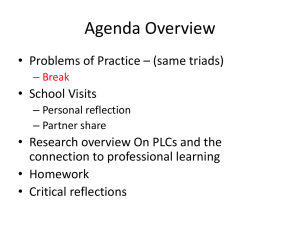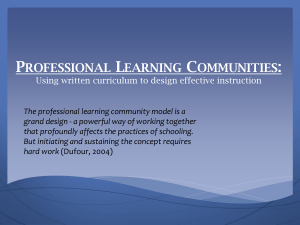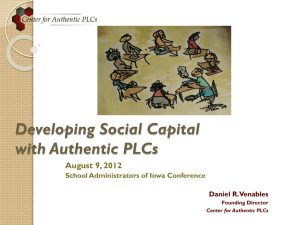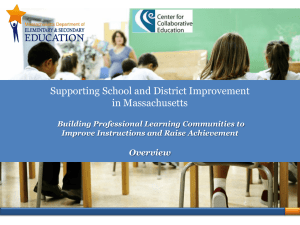Professional Learning Communities at the Crossroads:
advertisement
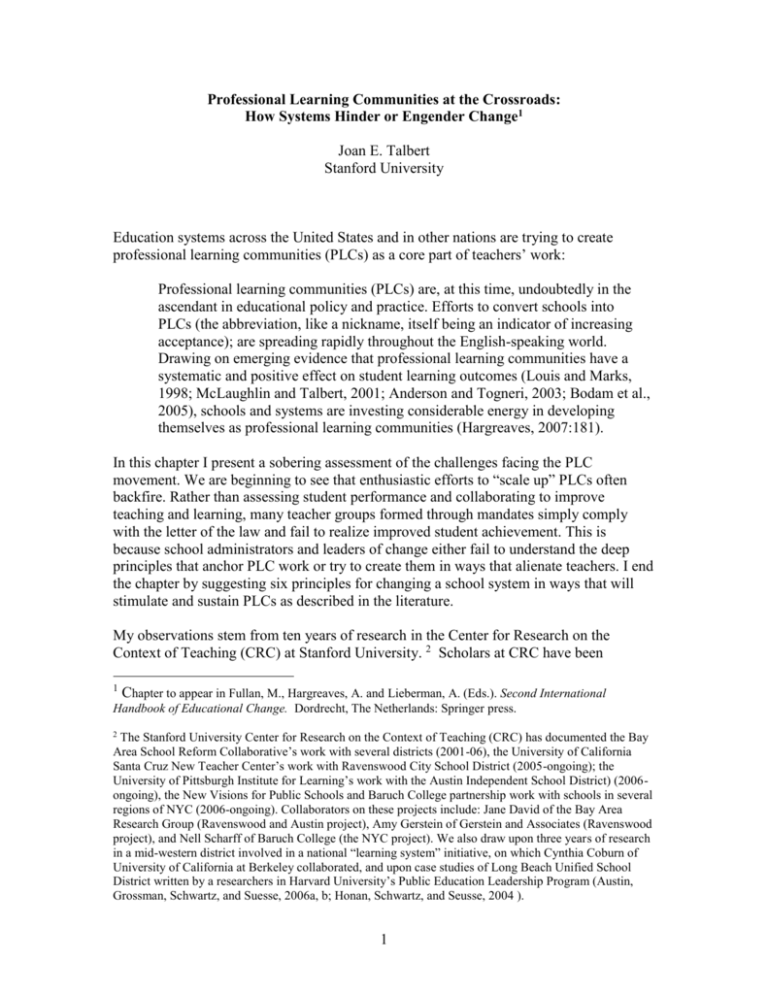
Professional Learning Communities at the Crossroads: How Systems Hinder or Engender Change1 Joan E. Talbert Stanford University Education systems across the United States and in other nations are trying to create professional learning communities (PLCs) as a core part of teachers’ work: Professional learning communities (PLCs) are, at this time, undoubtedly in the ascendant in educational policy and practice. Efforts to convert schools into PLCs (the abbreviation, like a nickname, itself being an indicator of increasing acceptance); are spreading rapidly throughout the English-speaking world. Drawing on emerging evidence that professional learning communities have a systematic and positive effect on student learning outcomes (Louis and Marks, 1998; McLaughlin and Talbert, 2001; Anderson and Togneri, 2003; Bodam et al., 2005), schools and systems are investing considerable energy in developing themselves as professional learning communities (Hargreaves, 2007:181). In this chapter I present a sobering assessment of the challenges facing the PLC movement. We are beginning to see that enthusiastic efforts to “scale up” PLCs often backfire. Rather than assessing student performance and collaborating to improve teaching and learning, many teacher groups formed through mandates simply comply with the letter of the law and fail to realize improved student achievement. This is because school administrators and leaders of change either fail to understand the deep principles that anchor PLC work or try to create them in ways that alienate teachers. I end the chapter by suggesting six principles for changing a school system in ways that will stimulate and sustain PLCs as described in the literature. My observations stem from ten years of research in the Center for Research on the Context of Teaching (CRC) at Stanford University. 2 Scholars at CRC have been 1 Chapter to appear in Fullan, M., Hargreaves, A. and Lieberman, A. (Eds.). Second International Handbook of Educational Change. Dordrecht, The Netherlands: Springer press. 2 The Stanford University Center for Research on the Context of Teaching (CRC) has documented the Bay Area School Reform Collaborative’s work with several districts (2001-06), the University of California Santa Cruz New Teacher Center’s work with Ravenswood City School District (2005-ongoing); the University of Pittsburgh Institute for Learning’s work with the Austin Independent School District) (2006ongoing), the New Visions for Public Schools and Baruch College partnership work with schools in several regions of NYC (2006-ongoing). Collaborators on these projects include: Jane David of the Bay Area Research Group (Ravenswood and Austin project), Amy Gerstein of Gerstein and Associates (Ravenswood project), and Nell Scharff of Baruch College (the NYC project). We also draw upon three years of research in a mid-western district involved in a national “learning system” initiative, on which Cynthia Coburn of University of California at Berkeley collaborated, and upon case studies of Long Beach Unified School District written by a researchers in Harvard University’s Public Education Leadership Program (Austin, Grossman, Schwartz, and Suesse, 2006a, b; Honan, Schwartz, and Seusse, 2004 ). 1 studying initiatives to create teacher PLCs in schools and to change school districts into learning organizations. All are struggling to get it right – to achieve the vision of teachers’ collaborating to continually improve student achievement. Even when administrators and their initiative partners are well versed in the literature on PLCs and have a good handle on system conditions that support and sustain them (Kruse and Louise 2007; McLaughlin and Talbert 2006), they lack guidance on ways of changing the professional culture of a system. We find that system conditions that support the work of PLCs – such as a comprehensive education plan, integrated learning resources, local knowledge resources, robust data and accountability system, extended time for teacher collaboration, and leaders committed to PLCs – are not sufficient to engender change in professional culture and teachers’ work lives. The literature points to goals for system change, but offer little guidance on the change process or warning of pitfalls and challenges entailed in changing professional culture from the top. With all good intentions and research-based knowledge, district and school administrators sometimes create policies and routines that interfere with progress, and they wonder why teachers respond in unanticipated ways. Instead of jumping into collaboration with their colleagues, teachers sometimes organize to oppose new designs for their work or enact them in a routine fashion. This chapter addresses the question of why teachers respond negatively to PLC initiatives that aim to increase their professional judgment and accountability. First I discuss core principles of a PLC and how they challenge typical school culture. Then I describe two paradigmatic approaches to PLC development and how participants typically respond to each approach. And finally I draw lessons from school district experience with PLCs and identify the obstacles that must be overcome if this approach to improved student learning outcomes is to be successful. PLC Principles and Challenges for School Culture Change School system leaders who promote a PLC initiative are familiar with the literature and more or less deeply knowledgeable about PLC principles and practices. The change strategies and policies they develop target these outcomes. How well they craft these strategies, and how teachers respond to them, depend upon their understanding of the problems of changing professional cultures. Literature on professional learning communities documents the social, technical and organization conditions that enable them to grow and flourish in schools. Key conditions are: Norms of collaboration Focus on students and their academic performance Access to a wide range of learning resources for individuals and the group Mutual accountability for student growth and success 2 These PLC features have been documented repeatedly in studies of teaching and coincide with conclusions from research on how people learn and environments that support learning.3 Creating these conditions is the core challenge facing system initiatives that aim to develop PLCs. Yet, school and district leaders do not instinctually know how to promote these conditions of teachers’ work. In fact, common administrative practices and patterns of inequality across district schools often undermine them. Urban school systems serving poor students of color often fall short on the human, social, political, and material resources needed to develop these conditions of teachers’ work. Let’s take the PLC conditions one by one and consider what they look like and what kind of challenges they present for system change. Norms of collaboration Teachers in a well functioning PLC work together to improve teaching and learning for students. Whether in grade-level groups in elementary schools, in subject areas in middle and high schools, or in small learning communities of restructured high schools, teachers collaborate to improve the performance all students. The forms and depth that their collaborative work takes varies (Little and Horn, 2007; Hipp and Huffman, 2007), and depth of PLC work develops gradually with leadership and organizational supports (McLaughlin and Talbert, 2006). The challenges of developing teacher collaboration are many. One stems from a tradition of autonomy in teaching that works against the formation of PLCs (Lortie, 1975; Little, 1982, Smylie, 1994). When instruction is considered private practice, teachers resist the idea of collaborating with colleagues on instruction. They resist even more the opening of classrooms to peer observation and subsequent feedback. Most teachers shy away from discussing the link between teaching and student learning When PLCs operate as intended—as sites for improving instruction and student outcomes— they are in conflict with the norms of collegial relations in U.S. schools. Local career systems can also operate against PLCs. The most senior and effective teachers often bid for openings in high-achieving schools, creating a “revolving door” labor force in the least desirable, lowest-performing schools. Teacher turnover undermines social cohesion and sustained teacher collaboration in the schools most challenged in improving student achievement.4 3 Bransford, Brown & Cockings (1999), How People Learn. Washington, DC: National Research Council. In the NRC report’s language, effective learning environments are: community-centered, content-centered, learner-centered, and assessment-centered.. 4 In a 100-school district we studied, statistical analysis showed a strong positive effect of mean teacher experience on teacher community strength (.40), with student poverty level controlled; student poverty was correlated -.66 with teacher experience. 3 And, there are often limited opportunities for teacher collaboration in a normal school schedule. Even when more time is arranged for teachers to work together, the issue shifts to how the time is used. In many instances, and especially in lowest-performing schools, external pressures to raise test scores pull teachers away from peer collaboration towards after-school tutoring and test preparation. Collaboration time is trumped by work designed to shore up student test scores in the short run. Focus on improving student’s success Teachers’ collective focus on student learning is central to the vision of a PLC. In the best cases teachers use student achievement data from a wide variety of assessments to continually evaluate and adjust their instruction. When teachers jointly assess the performance of their students – using disaggregated test data, formative assessments, student work, and low-inference classroom observations – they are able to more effectively craft interventions to meet all students’ learning needs. They learn from their interventions what works and what needs to be changed. This focus for PLC work comes up against a competing conception of effective teaching practice. Federal and state accountability systems enforce a view of teaching as implementing a set curriculum according to a pacing guide. Districts are forced to adopt “best curricular programs,” and low-performing districts place pressure on teachers to implement them with “fidelity” in their classrooms. This silver-bullet approach detracts from a view of teaching as involving judgments and a vision of PLCs as analyzing student learning and crafting ways to address performance gaps. Ironically, accountability systems push in both directions, and school districts find themselves in the position of having to resolve competing paradigms and pressures for improvement. System leaders who place priority on nurturing PLCs – developing their capacity to make sound collective judgments to address student learning needs – are challenged to take a stand against the curriculum implementation model of change. School systems also face technical challenges of building a culture focused on student learning. Many lack data systems and formative assessments that meet teachers’ needs for fine-grained information on student skills and knowledge. Change thus entails investments in data infrastructure, including high-quality formative assessments for multiple subjects and grade levels. Yet teachers often lack skills and experience in using data well. So districts are challenged also to developing teachers’ skills in using a wide range of data to assess student performance gaps and to evaluate instructional interventions on an ongoing basis. This core condition of PLC success develops over time and involves a steep learning curve for most teacher groups. Exploitation of diverse knowledge resources The vibrant PLCs that continually learn how to improve student achievement are networked with colleagues in local universities and professional networks within and outside their school system. They tap the expertise of these colleagues as they grapple with instructional problems – through email exchanges, and formal and informal 4 meetings (Mitchell and Sackney, 2007; Jackson and Temperley, 2007; Stoll, Roberston, Butler-Kisber, Slar and Whittingham, 2007). PLCs build their knowledge and skills through experimentation, as well as through boundary exchanges. They develop and share tools and materials effective in their classrooms, circulate and discuss readings, and use protocols to learn together from the work of their students. In short, PLCs seek and develop rich and extensive knowledge resources to support their learning for improved instruction. Schools with high proportions of beginning teachers, commonplace in urban school systems, are handicapped in their knowledge resources. This is because accomplished and well-networked teachers are pivotal to a PLC’s learning and capacity to support new teacher induction (McLaughlin and Talbert, 2001). Not surprisingly, schools where most teachers are weak in subject preparation and/or inexperienced show the least progress on PLC development (CRC, 2002). How many expert teachers, or what proportion of the total, are needed in a school, department, or grade-level teacher community is not known. But district and school administers are challenged to address the “critical mass” question: what is the threshold of well-prepared and experienced teachers needed for a PLC to become successful? Mutual accountability for student growth and success PLCs depend upon shared commitment to improving learning opportunities and achievement for all students. Only a few departments in the California and Michigan schools we studied in the 1990s had such a professional culture. Most lacked a “service ethic,” or stance to meet all students’ learning needs (Talbert and McLaughlin, 1994). Instead, they shared a view that some children cannot succeed because of their difficult home and neighborhood situations and there is little that teachers can do. The “learning communities” we found stood out for their persistent effort to ensure that none of their students fell through the cracks and that none of the teachers in their department floundered (McLaughlin and Talbert 2001). These teachers shared responsibility for the success of all their students; they supported one another’s learning and improvement; and they organized the curriculum and teaching assignments to ensure that all teachers had classes with struggling students. They challenged the typical practice of tracking courses and of assigning the most experienced and skilled teachers to the most successful students. The development of mutual accountability among teachers prompted them to work in ways that went against the grain of tracked learning opportunities in American high schools (McLaughlin and Talbert, 2001; 2007). Centralized accountability systems can work against the development of mutual teacher accountability. Their emphasis on near-term gains in test scores pushes a pace of change that undermines the development of PLCs. Norms of collective responsibility and collaboration develop slowly. Further, emphasis on individual teacher quality, curriculum implementation in each classroom, and monitoring of teaching fidelity undermines principles of collective responsibility and improvement. Teachers’ attention is focused on compliance rather than accountability to colleagues for developing new instructional interventions that work with their students. Efforts to isolate and reward 5 “successful teachers” through merit pay schemes can further pull away from PLC accountability unless the notion of success and merit place weight on a teachers’ effectiveness in mentoring new teachers and collaborating with colleagues to achieve student success in the school. The challenge for system change is to nurture a service ethic among teachers and engender their mutual accountability for improving student achievement. ***** Initiatives to implement PLCs are relatively new on the landscape of education reform. To succeed they must take on the challenges of change toward each of the PLC conditions – collaborative practice, focus on students, use of diverse knowledge resources, and mutual accountability. How they do so – how school and system administrators go about changing conditions on each front – is also pivotal to the success or failure of a PLC initiative. Bureaucratic versus Professional Strategies for Change The strategies a school district uses to create PLCs make a great difference in outcomes. Even if school system leaders share a research-based vision of PLC principles and practices, they often have radically different conceptions of what it takes to get there. Some see mandates, implementation checklists, and sanctions to ensure accountability as key levers for change. Others see change linked to leadership by example, tools and facilitators for learning, and rewards for risk-taking. In theoretical terms, they differ in embracing a bureaucratic strategy on the one hand, and a professional strategy on the other.5 The distinction here is not between top-down and bottom-up views of educational change. Both are top-down in that they use organizational authority and resources in an attempt to change the culture and practice of teaching.6 Both use authority and policies to establish essential PLC resources, such as increased teacher meeting time, improved student data systems, and dedicated staff support. However, they differ in their underlying theory and approach to changing the system’s professional culture. A “bureaucratic strategy” uses traditional management tools of directives and rules, prescribed routines, and sanctions for compliance as ways to promote change. A “professional strategy” uses tools of decision-making structures, professional expertise and knowledge resources, and leader modeling and feedback to engender change. 55 In his classic study Schoolteacher, Dan Lortie (1960) portrayed the growth of education bureaucracies as a threat to teacher professionalism. A long tradition of sociological theory treats bureaucratic authority and professional authority as fundamentally opposed modes of organizing work, with work controlled through hierarchy, rules, and organization sanctions in the former and through professional expertise, standards, and mutual accountability in the latter. 6 See Kruse and Louis, 2007, on this distinction and for further evidence that centralized strategies can support PLCs. 6 In reality these are not mutually exclusive system change strategies. Indeed, it appears that they typically coexist and compete in school system where leaders embrace different views of how to create PLCs. Competing logics for organizing change emerge early in a PLC initiative and prompt different tacks on developing the core features of PLCs outlined above, or how they go about: Establishing expectations and norms for collaboration Focusing PLC work on improving all students’ achievement Creating knowledge resources for PLCs Engendering mutual accountability for success. Whether district leaders use a bureaucratic or professional approach to creating these system conditions matters for how teachers and principals respond to them and how effectively the system advances on its PLC agenda. Bureaucratic patterns A school system signals a bureaucratic approach to PLC if it labels the effort, funds it through an external grant, and designates individuals (or a specialized unit) to manage it. This denotes a special project whose fate depends upon a particular funding source and the career path of the project leaders. Throughout the system, people draw on their experience with such initiatives to conclude that “this too shall pass.” System leaders and staff who develop a project approach then work to develop technical capacity for PLCs in schools – data systems, specialized roles and training – and use lines of authority to implement them. They tend not to engage the cultural and political challenges of system change, nor to see change in developmental terms. Mandating teacher collaboration. Once policies that establish PLC meeting times are in place, system leaders will direct principals to ensure that the time is used for teacher meetings. Teacher teams are then defined by grade level at the elementary level, by content area at middle school level, and by subject department or Small Learning Community at the high school level. Usually the directives specify a particular model that the PLC work should follow, such as data-based inquiry or study lessons in content areas. Directives typically require that principals enforce teacher attendance at PLC meetings, through record-keeping and monitoring, and by tying the meetings to contract requirements. In one large urban district we followed, an external management consulting firm developed an elaborate set of project management tools for the PLC project. The tools included a monitoring strategy for all system roles (specifying activities for each role, frequency, and follow-up), an implementation check-list for central office administrators and principals to use for monitoring progress, a meeting planning template for use by designated leaders, and a rubric to assess PLC quality. On one hand, these tools created essential expectations and structures to focus discussion and work around the PLC development initiative. On the other hand, the project management tools framed the 7 system culture change effort in bureaucratic control terms. This orientation and the daunting number of guidelines and schedules accompanying the project management approach, risked sacrificing principled conversations and understandings of the vision. In some instances, the schedules put forth were unrealistic in terms of PLC developmental processes. Suggesting that “full implementation” would be complete within a year’s time is one example of undermining the process. A project management approach signals a compliance orientation to the PLC initiative – prompting administrators to focus on completing forms and monitoring teacher compliance. In the case of this district, however, top administrators who embraced a professional logic for change balanced the bureaucratic frame brought by implementation and monitoring tools. These system leaders ensured that final drafts of project management tools did not include inappropriate monitoring criteria and unrealistic time frames for the change process. Directing PLCs to meet benchmarks for closing student achievement gaps. District leaders of this stripe frequently translate PLC work in terms of meeting student achievement benchmarks adopted in compliance with accountability system demands. They emphasize the use of standardized test data for monitoring student progress and identifying achievement gaps. They expect teacher groups to focus their work primarily on raising student scores on high stakes assessments. Creating roles and responsibilities for PLC leadership. Most systems create a new “coach” or “lead teacher” role to support the development and learning of PLC’s in schools. A bureaucratic approach to establishing knowledge resources for PLCs usually stops with the creation of specialized roles, expecting these individuals to transmit particular kinds of knowledge and skills, e.g., how to read student achievement data reports, or how to implement a curriculum. Typically, little attention is paid to the learning demands on individuals assuming the role of PLC leader, or their need for support and conferred authority from school administrators. We have seen that an approach that rests on lead teacher selection, brief training, and marginal incentives results in highly uneven performance among incumbents. Individual success stories often depend upon prior experience and/or access to expertise through long-developed professional ties. The bureaucratic approach to change tends to ignore the social nature of learning and the key role that professional networks play in PLC development and success. PLC knowledge resources are limited absent investments in developing and supporting teacher and specialist networks within and beyond the system,. Establishing PLC’s accountability to higher authorities. In contrast to the PLC principle of mutual accountability among teachers, bureaucratic conceptions of accountability focus on hierarchical relationships. School district leaders invent ways for administrators to evaluate and sanction PLC work. Administrators might adopt PLC checklists and monitoring systems of the sort mentioned above, content specialists might create and use 8 pacing guides to track implementation of the curriculum, and principals might require teachers to turn in records of their PLC meetings as evidence of compliance with district requirements. The more school and district leaders feel pressed to respond quickly to state and federal accountability systems, the more likely they are to put demands on teacher groups to demonstrate progress and to use sanctions to enforce them. However, top-down accountability systems undermine mutual accountability among teachers within a PLC. They focus teacher attention on narrow, short-term criteria for success that divert them from grappling with both bigger and more fine-grained issues of student learning and teaching that ground effective PLC interventions and create shared accountability for results. Norms of collective responsibility develop gradually through joint work and shared struggles, and bureaucratic accountability schemes both carry the wrong frame and pull teachers away from work that matters. Teacher responses. Effective PLCs do not develop and thrive when they are perceived as a mandate for collaboration, as increased pressure to meet benchmarks for student achievement, as unsupportive of their learning needs and improvement efforts, and as creating more paper work and teacher evaluation criteria. Project management strategies for PLCs remind teachers of all the other top-down reforms that have come and gone and of the mounting pressures they feel from federal and state accountability systems. This paradigm for change runs counter to professionalism. Teachers’ responses to top-down bureaucratic approaches tend toward three broad patterns: compliance, resistance, and anxiety. Each response interferes with joint work and risk-taking. Compliance takes the form of ritual enactment of the PLC requirements, usually without substantive engagement. Teachers show up for the required meetings and use the time for their own paper work. They tell stories about students and vent to their colleagues. Most often they just complain about system requirements. Resistance is a variant that challenges the goals and focus of the initiative. In these instances, teachers challenge the core assumption of PLCs—that failing students can be taught to achieve. They attack the validity or value of prescribed PLC work (e.g., analyzing student achievement data); they question the legitimacy of using their time and school resources to support such work; and/or, they question the role of the designated leader. At the extreme, resisters refuse to attend PLC meetings. Anxiety responses are common among novice teachers who lack the job security and/or cynicism that prompts compliance or resistance among veterans. For new teachers, bureaucratic approaches to a PLC initiative can exacerbate anxieties that come from struggles in the classroom and pressures to raise test scores. In one district where several new teachers were selected to lead PLCs, veteran teachers undermined their leadership and posed yet another threat to their professional self-efficacy and security. Professional approaches to changing system culture System leaders who embrace a logic of professionalism to craft strategies for developing PLCs avoid labeling or compartmentalizing the effort in ways that connote bureaucratic mandates. They approach the challenge of developing PLCs as partly a matter of 9 changing one’s perspective on the system—that it need not constrain judgments or present bureaucratic hurdles. Such leaders focus on developing new conceptions of professional work and relationships in the system, building partnerships and networks to support professional learning, and limiting damage from federal and state accountability systems. Their policies and actions are based on a theory of changing system culture that is grounded in PLC principles. Building a shared vision and leaders’ capacity to support change. As a first step toward developing a collaborative teacher culture, system leaders organize conversations and learning opportunities for top administrators to develop a shared vision of the goals and challenges of change. In the successful initiatives we studied, top administrators participated in multiple venues designed to deepen their understanding of PLC principles and the substantive focus of their work, e.g., data-based inquiry or disciplinary instruction. And they took the lead in designing school and system change strategies and practices that were guided by PLC principles. Key among these approaches to system change is developing a PLC for principals. Principals met regularly to share their struggles and learn from one another about developing PLCs in their own schools. Because of their formal authority and interstitial position in a district system, school administrators set the stage for starting and sustaining the community development process. They can use organizational resources and persuasion to leverage teacher involvement in facilitated work. And they can broker resources from within and outside the system. For example, school administrators who made a difference in schools we followed had a number of strategies in common. They defined a vision for how collaboration time would be used; were strategic in how they used coaches or facilitators to support PLCs in the school; used base budget slack and categorical funds to support teachers’ innovations; invested in developing a wide range of student assessment data and supported its use by teachers and teacher teams; identified and hired skilled teacher educators and facilitators outside the system to support PLC improvement efforts; and supported participation of teachers in local, state, and national professional networks and high-quality off-site professional development. Research and practitioner reflection on effective school change has identified particular strategic roles that school administrators play in moving schools through stages of PLC development (CRC, 2002: McLaughlin & Talbert, 2006; Mohr and Dichter, 2001). For example, during the “novice stage” of community development, change focuses on building social trust and norms for group decision-making. At the “intermediate stage,” change centers on sustaining collaborative work when the pay-offs are uncertain and the faculty fears that its work is unproductive. At an advanced stage of PLC the challenge is to keep the community from resting on its laurels and to press for ever-higher outcome standards. Effective leadership addresses the challenges for change at each stage. Developing capacity to address student achievement gaps. Using student data to inform decisions entails big changes in current professional culture. It means a) shifting focus from teacher practice to student practice and success, b) developing and using a variety of student assessments and data to identify individual learning gaps, c) designing 10 interventions to address identified gaps in student learning, and d) using student achievement data to evaluate and refine the intervention. Yet system accountability pressures focus principal and teacher attention on standardized test scores and drive a pace of change that works against PLC development. Principals and district leaders play a key role in keeping these outside pressures from squelching long-term change efforts. For example, Long Beach district administrators opted to not focus their communications with school administrators on federal No Child Left Behind (NCLB) benchmarks or sanctions. Instead, they focus on the district goal of continually developing professional capacity to improve student outcomes, understanding that this sustained message and effort will pay off in desired student achievement gains. Developing a web of knowledge resources for PLCs. District leaders who embrace a professional approach invest in resources designed to create learning environments for teachers and other professionals that are learner-centered, knowledge-centered, assessment-centered, and community-centered.7 Most centrally, they ensure that middlesystem specialists and coaches in schools have strong grounding in both the designated work of PLCs and skills in facilitating their development and learning. This system capacity is typically built through partnering with a local intermediary organization or university that has a track record for high quality leadership development. Districts also are developing ways to capture and use knowledge of effective professional practice developed within the system. For example, strong PLCs can be resources for system-wide learning when they are authorized to develop and share knowledge of their improvement practices and effective instructional designs. The use of clinical knowledge for school and district-wide improvement is powerful because it provides concrete, situated illustrations of principles for professional practice. A local learning system brokers both clinical and research-based knowledge of effective practice and provides teachers and school leaders with access to skilled professionals within and outside the system (Supovitz, Forthcoming) Knowledge resources from research and professional practice outside the system are essential to PLC learning and improvement. Districts using this approach to PLC development thus encourage and broker educators’ involvement in professional networks and associations, such as the National Writing Project and Councils of Teachers of Mathematics. They build partnerships with teacher education institutions in the region to ensure that teachers are well-prepared, adequately supported in their first years on the job, and oriented to collaborative work with colleagues. For example, Long Beach has a partnership with the local State University’s teacher education program that establishes a pipeline for teachers into the district that carries strong standards for content instruction and for collaboration with colleagues on instructional improvement. Establishing mutual accountability among professionals. Moving away from a top-down notion of professional accountability to one of professionals holding one 7 These are the conditions of effective learning environments identified by the National Research Council panel on learning (Bransford, Brown, and Cockings, How People Learn,1999) 11 another accountable is key to PLC development. In districts where this transition has occurred administrators have taken a long-term view of change toward a culture of professionalism. They avoid focusing educators’ and administrators’ attention on how their school or district rates on state accountability reports, instead promoting their use of formative assessments to continually gauge student outcomes and design interventions. In doing so, they locate judgments of progress and accountability for improving student performance within teacher and school communities. Patterns of teacher responses. Teachers are more receptive to a top-down design for PLC development that uses a professional (as against a bureaucratic) frame. This is not to say that they are always ready or eager for change. Teacher responses to professional change efforts after a year tend toward three patterns: enthusiasm, cooperation, and wait-and-see. Enthusiasts are those who were enlisted as leaders of PLCs and who received significant professional development to support their work with colleagues. Some teachers who have taken on these roles report that this has been the most powerful learning experience of their career. Cooperators with the PLC agenda are sometimes ambivalent in judging whether the time spent in meetings with colleagues is worthwhile, but they are willing to try to figure out how they might work together. Wait-and-see folks stand by to see how the work will go. They are, in theoretical terms, “legitimate peripheral participants” (Wenger, 1998), observing the work but not actively participating in it. Over time, such teachers are likely to join and come to identify with the community of practice. Table 1 highlights differences between a bureaucratic and professional approach to building PLCs across a school system and differences in teachers’ responses to them. [Table 1 here] An observation and hypothesis from our research across several districts is that professional strategies take hold most readily when they are linked to prior system reform efforts that were grounded in the same principles, such as a foundation-funded initiative or district partnership that engendered PLC development. Organizational memory creates a bridge to future change when system leaders communicate the common principles and draw upon professional networks and leadership developed through the earlier reform work. Conclusions and Implications for Changing School Systems toward PLCs Professional community building is not just about creating or defining collaborative work for teachers. Nor is it just about using tools for teachers to use in tracking and evaluating their work with students. It is also about addressing normative and organizational challenges for change – shifting a focus on teaching toward student learning, creating rich knowledge resources and networks, and engendering a social service ethic and mutual accountability. It is about changing the way schools and the school system operate and how professionals at all system levels work to foster success for all students. It is about changing the system from a culture of bureaucracy to a culture of professionalism and using bureaucratic resources to do so. Such profound system culture change takes time 12 and is both driver and outcome of the development and vigor of teacher learning communities across the system (McLaughlin & Talbert, 2006). Lessons learned from districts’ experiences working to implement the vision reveal several key challenges and principles for changing a system to stimulate and sustain PLCs. First, system change entails dynamic tensions between bureaucratic and professional perspectives and strategies. Because local school systems are bureaucratic organizations by nature, history, and broader administrative context, their agenda to create PLC norms and practices poses numerous challenges to re-invent ways of doing business. Administrators need to become clear about which organization functions can be maintained best by bureaucratic means, and which should shift to professional strategies. Schools and system units charged with improving instruction are challenged to resist routines and decisions rooted in bureaucratic habits of mind as they invent policies and practices to engender PLCs. Second, deep understanding of the core principles of PLCs grounds effective change strategies. System approaches to engendering PLCs must develop through leaders’ understanding of both the what and why of changing professional culture. All of the core PLC principles are key – collaboration, focus on students, access to knowledge resources, and mutual accountability – and each is inhibited by teaching conventions or typical system conditions. Change strategies call upon particular kinds of system resources – knowledge and expertise, time and money, external partners, and policies. The effective use of these resources depends upon a deep understanding of the principles and challenges of change. Third, changing professional culture is a developmental process. System designs for PLC development need to stimulate and support gradual change in teacher beliefs, norms, and practices across diverse schools. Schools and teacher groups within them inevitably begin at different stages of “PLCness,” and system strategies must address these differences in order to effectively support system-wide change. Bureaucratic approaches to leveraging change back-fire in part because they fail to take into account the developmental nature of change. They assume that mandates and designs for PLCs can be readily implemented. But even professional strategies fall short when they lack sufficient attention to developmental trajectories for change, differences in school and teacher groups’ experience and culture, and effective supports for change at all developmental stages. Fourth, changing a system toward PLCs requires coherent professional strategies, polices, and practices at all levels of the system over time. The problem of changing system culture from bureaucratic to professional norms and practices requires the coalescing of widely diverse resources and perspectives around a shared vision of PLCs. School systems are complex, multi-level organizations in which units and people within them have different responsibilities and roles, different levels and kinds of authority, different histories in the organization and in education, different knowledge and different 13 views of the problem of improving student learning. As a consequence they will unite their work only through shared visions and principles communicated and sustained by leadership at all system levels. Fifth, system leadership for PLCs should mobilize bureaucratic resources to implement professional strategies. The allocation of resources of all kinds – base budgets, titled funds, personnel, equipment, and space – determines a system’s capacity to develop PLCs. District administrators think about and allocate resources differently when these decisions are made with an eye to supporting vital teacher learning communities in schools, as opposed to ensuring compliance with bureaucratic regulations or accommodating political pressures. A learning system stance directs administrators to map the totality of district resources from public and private sources for professional development and to assess both their coherence and equitable distribution. Key to building teacher learning communities is the integration of resources to provide support for school change and high quality learning opportunities across the system Finally, system leaders must manage context pressures and politics in ways that sustain and mobilize support for long-term, professional strategies for developing PLCs. State and federal accountability pressures and systems threaten change because they bring bureaucratic frames to local improvement efforts, instill fears of professional and organizational sanctions that undermine innovations, and discourage investments in longterm change. System leaders need to buffer schools from these impacts in order to sustain PLC development and effectiveness. School systems face a huge challenge in building political commitment for significant reform of any kind. The challenge is no less for PLCs. A proactive partnership with teacher and principal professional organizations is crucial. Union contracts can either inhibit the redesign of teachers’ work or enable and promote change. A school board or other governing body that is knowledgeable and supportive of the PLC agenda is also essential, both for authorizing system investments in change and for promoting it among stakeholders in the community. Informed political support of parents, members of the business community, and the civic elite is indispensable to significant school reform.8 At its crossroads, the international education movement to develop a new paradigm for teaching -- one that features PLCs and greater professional control and accountability – will grow and be sustained to the extent that local systems take up the challenges for change outlined here. Administrators and leaders at all system levels will need to resist tendencies toward bureaucratic habits of mind and strategies and invent new ones, adapted to their particular system context, that are grounded in PLC principles and professional approaches to system change. 8 See Hill, Campbell, Harvey (2000) on civic capacity for reform and McLaughlin & Talbert (2006) on civic capacity for PLC development. 14 References Anderson, S. and Togneri, W. (2002). Beyond Islands of Excellence: What Districts Can Do to Improve Instruction and Achievement in All Schools. Washington, DC: Learning first Alliance. Andrews, D. and Lewis, M. (2007). Transforming practice from within: The power of the professional learning community. In Stoll, L. and Seashore Louis, K. (Eds), Professional Learning Communities: Divergence, Depth and Dilemmas. Berkshire, England: Open University Press. Austin, J. E., Grossman, A. S., Schwartz, R.B, and Suesse, J. S. (2006a). Managing at Scale in the Long Beach Unified School District, Cambridge, MA: Public Education Leadership Project at Harvard University. Austin, J. E., Grossman, A. S., Schwartz, R.B, and Suesse, J. S. (2006b). Long Beach Unified School District (A): Change that Leads to Improvement (1992-2002) Cambridge, MA: Public Education Leadership Project at Harvard University. Bodam, R., McMahon, A., Stoll, L., Thomas, S., Wallace, M., Hawkey, K. and Greenwood, A. (2005). Creating and Sustaining Effective Professional Learning Communities. DIES Research Report RR637, University of Bristol. Bransford, J. D., Brown, A. L. and Cocking, R. R. (Eds). (1999). How people learn: Brain, mind, experience, and school. Washington, D.C.: National Academy Press. Center for Research on the Context of Teaching (2002). Bay Area School Reform Collaborative: Phase One (1996-2001) Evaluation. Stanford University, Stanford, CA:Author. Hargreaves, A. (2007). Sustainable professional learning communities. In Stoll, L. and Seashore Louis, K. (Eds), Professional Learning Communities: Divergence, Depth and Dilemmas. Berkshire, England: Open University Press. Hill, P. T., Campbell, C. and Harvey, J. (2000). It Takes a City: Getting Serious About Urban School Reform. Washington, DC: Brookings. Hipp, K. K. and Huffman, J. B. (2007). Using assessment tools as frames for dialogue to create and sustain professional learning communities. In Stoll, L. and Seashore Louis, K. (Eds), Professional Learning Communities: Divergence, Depth and Dilemmas. Berkshire, England: Open University Press. Honan, J. P., Schwartz, R. B., and Suesse, J. M. (2004). Long Beach Unified School District (B): Working to Sustain Improvement (2002-2004). Cambridge, MA: Public Education Leadership Program at Harvard University. 15 Jackson, D. and Temperley, J. (2007). From professional learning community to networked learning community. In Stoll, L. and Seashore Louis, K. (Eds), Professional Learning Communities: Divergence, Depth and Dilemmas. Berkshire, England: Open University Press. Kruse, S. D. and Louis, K. S. (2007). Developing collective understanding over time: reflections on building professional community. In Stoll, L. and Seashore Louis, K. (Eds), Professional Learning Communities: Divergence, Depth and Dilemmas. Berkshire, England: Open University Press. Little, J.W. (1982). Norms of collegiality and experimentation: Workplace conditions of school success. American Educational Research Journal, 19: 325-40. Little, J. W. and Horn, I. S. (2007). ‘Normalizing’ problems of practice: converting routine conversations into a resource for learning in professional communities. In Stoll, L. and Seashore Louis, K. (Eds), Professional Learning Communities: Divergence, Depth and Dilemmas. Berkshire, England: Open University Press. Lortie, D.C. (1975). Schoolteacher: A sociological Study. Chicago: University of Chicago Press. Louis, K. S. and Marks, H. (1998). Does professional community affect the classroom? Teachers’ work and student work experiences in restructuring schools, American Journal of Education, 106: 532-575. McLaughlin, M. W. & Talbert, J. E. (2001). Professional Communities and the Work of High School Teaching. Chicago: University of Chicago Press. McLaughlin, M. W. & Talbert, J. E. (2003). Reforming districts: How districts support school reform. University of Washington: Center for the Study of Teaching and Policy. McLaughlin, M. W. & Talbert, J. E. (2006). Building School-based Teacher Learning Communities: Professional Strategies to Improve Student Achievement. New York: Teachers College Press. McLaughlin and Talbert. (2007). In Stoll, L. and Seashore Louis, K. (Eds), Professional Learning Communities: Divergence, Depth and Dilemmas. Berkshire, England: Open 2222University Press. Mitchell, C. and Sackney, L. (2007). Extending the learning community: a broader perspective embedded in policy. In Stoll, L. and Seashore Louis, K. (Eds), Professional Learning Communities: Divergence, Depth and Dilemmas. Berkshire, England: Open University Press. 16 Mohr, N. & Dichter, A.(2001). Stages of team development: Lessons from the struggles of site-based management. Providence, RI: Brown University, Annenberg Institute for School Reform. Petrides, L. and Nodine, T. ( 2005). Anatomy of school system improvement: Performance-driven practices in urban school districts. Half Moon Bay, CA: Institute for the Study of Knowledge Management in Education. Smylie, M. (1994). Redesigning teachers’ work: Connections to the classroom. In L. Darling-Hammond (Ed), Review of Research in Education, 20. Washington, D.C.: American Education Research Association. Stoll and Louis (2007) In Stoll, L. and Seashore Louis, K. (Eds), Professional Learning Communities: Divergence, Depth and Dilemmas. Berkshire, England: Open University Press. Stoll, Roberston, Butler-Kisber, Slar and Whittingham, 2007). In Stoll, L. and Seashore Louis, K. (Eds), Professional Learning Communities: Divergence, Depth and Dilemmas. Berkshire, England: Open University Press. Talbert, J. E. (2002). Professionalism and politics in high school teaching reform. The Journal of Educational Change. 3: 339-363. Talbert, J.E. & McLaughlin, M.W. (1994). Teacher professionalism in local school context. American Journal of Education. 102: 123-53. Wenger, E. (1998). Communities of Practice: Learning, Meaning, and Identity. Cambridge, England: Cambridge University Press. 17
